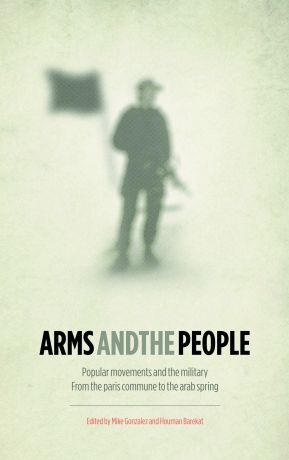Arts
You are here
Book review: Arms and the People

July 20, 2015
With the organization of every protest, with every news story about gun control, with every instance of police repression, activists are confronted with familiar questions: What about the police? How powerful is the state? How can we fight back when the bad guys have control of the army and all the weapons?
Arms and the People is a collection of essays edited by Mike Gonzalez and Houman Barekat that takes a look at examples of social movements throughout history in an attempt to answer some of those questions.
Workers in uniform
The book’s opening section looks at times when rising evolutionary movements convinced soldiers and sailors to revolt against the state that employed them. Examples such as Russia 1917, Germany 1918, Italy 1919-1921, and Portugal 1974, are explored as moments when those “workers in uniform” played decisive roles against the states and ruling classes who employed them and the officers who controlled them.
Social rupture caused by the toll of imperialist war, class conflict at home, disunion between the stated national goals and lived reality, and military defeats meant that when combined with the example of rebellion and revolt, soldiers would refuse to fight on the front and refuse to repress insurgent workers’ movements at home.
As Mike Haynes notes in the chapter on Russia: “a successful revolution cannot defeat a united army. The army must come over to the people and in such a way that it makes it an unstoppable force, not only against the old order but also against the potential of the officer class to seize power itself.”
When the old order is broken down, new kinds of armed power can come to replace the traditional professional military. Paris 1871 and Spain 1936 are incredible examples of when revolutionary armies or “mass armies,” populated not by professional soldiers or conscripts, volunteered to fight for ideals like equality, justice and socialism—and under a command structure that was based on direct democracy. The people’s militias that fought in Paris became models for the Workers and Soldiers Councils of revolutionary Russia and Germany that would come after them; direct democracy, instant recall of officials, representatives paid no more than the average workman’s salary were all ideals of an army of a new type.
The Vietnam War, Latin American Guerilla Movements in the last half of the 20th century provide examples of the limits of imperial power and the damage that politically-motivated bands of peasants could inflict on their own states and the armies of the world’s largest imperial superpower. The successes of the Viet Cong, the anti-war movement at home, combined with the apathy and anger of American troops meant that soldiers began to kill their officers rather than fighting the war that the Pentagon wanted them to in Vietnam.
Internationalism
This point underscores a central them in the book, which is the potential revolutionary fighting power of the working class, rank-and-file of professional soldier. As the introduction notes, the training of soldiers involves “persuading the rank-and-file fighter that he belongs to a different collective called ‘the Nation’ to whose defence he has committed his life. The Nation is an abstraction, yet ideology and ceremony combine to give a sense that it exists and that it is an undifferentiated whole in which peasant and landlord, worker and employer, share equally. The battle for the ‘military soul’ must first find a way to re-establish an identity of class and unmask the falsehood of the concept of a united nation.”
The historical examples contained in Arms and the People are moments when there was a distinct rupture in the idea of nationhood and duty in the soldier and things like class, race and international working class solidarity trumped duty, mission and national pride. These instances transformed soldiers from defenders of the status quo to powerful allies in the struggle for a new world. These are the ideals that motivated the popular mass armies that arose in Russia after 1917 and the people’s militias in France in 1871.
But these transformations are not automatic and what Arms and the People shows is that it is the duty of organized revolutionaries to be continually looking for opportunities to unmask the falsehood of national unity and highlight the class struggle at home and working class solidarity internationally. To lose this political battle can have tragic consequences, as the chapters on Indonesia and Chile show.
In a country where a government can advocate increased military spending and bombing campaigns around the world while simultaneously cutting financial support to military veterans, Arms and the People is a valuable book that highlights these brutal contradictions.
Section:










